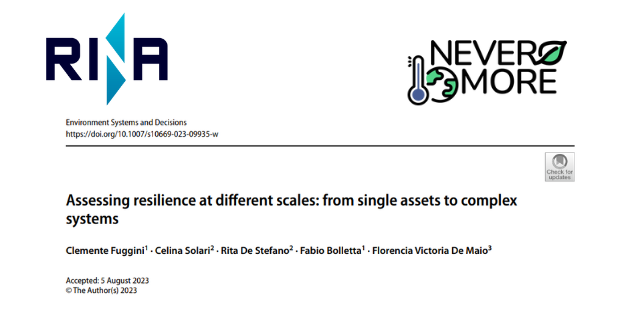The NEVERMORE project partner RINA-C successfully published the paper entitled “Assessing resilience at different scales: from single assets to complex systems”, in Environment Systems and Decisions.
The paper represents a significant analysis of future perspectives and potential strategies for resilience at local, urban, and national levels, while contributing to the commitment to ensuring infrastructure security. It leverages insights from the H2020 Secure Gas Project and the NEVERMORE Project to provide application cases.
The article co-authored by Clemente Fuggini, Celina Solari, Rita De Stefano, Fabio Bolletta & Florencia Victoria De Maio, emphasizes the importance of fortifying these systems against diverse threats.
The evolving landscape of threats and Resilience Assessment
In recent years, the significance of critical infrastructure (CIs) resilience has reached new levels, driven by the increasing awareness of their pivotal role in sustaining businesses, societies, and entire states. The escalation of damages to CIs, whether caused by natural disasters, threats posed by human interventions, or the interconnection of systems, has prompted a shift towards a more resilient approach.
The severity of damages to CIs is on the rise, fueled by the inevitable interconnection of infrastructures and the growing magnitude of both natural and man-made hazards. Climate change, with its annual damages reaching billions of dollars, plays a key role in this scenario. Governments and societies globally are aligning with international frameworks and agreements to mitigate the impact of climate change on critical infrastructures. The cost of building resilience is recognised as a wise investment, with an estimated $4.2 trillion in overall net benefits over the lifetime of new infrastructures.
Initially designed to protect single assets or systems from natural hazards, resilience assessment methods focused on entities like water infrastructure systems, transportation infrastructure systems, and power systems. Recent global events, such as the Russian-Ukrainian war and the COVID-19 pandemic, prompted an expansion of the scope to include healthcare systems, peacebuilding, and war under the resilience framework.
This evolution towards a broader approach involves formalizing the interconnection of infrastructures and studying threats related to cyber-security and hybrid nature. The spatial expansion of resilience frameworks has reached community, urban, and territorial scales, reflecting a comprehensive understanding of resilience across different levels.
The NEVERMORE Project: Revolutionizing Climate Change Assessment
The NEVERMORE Project represents a groundbreaking initiative addressing climate change assessment. Unlike traditional silo approaches, NEVERMORE adopts an integrated methodology to assess climate change impacts, risks, and interactions across sectors. This project exemplifies a paradigm shift, strategically allocating assets within a broader spatial context. By integrating information from physical modeling and risk analysis across various scales, from national to local levels, NEVERMORE showcases flexibility and feasibility. The project’s core aim is to identify vulnerable areas, enabling targeted resilience enhancement. Emphasizing threat characterization and risk analysis, NEVERMORE’s adaptable approach accommodates assessments at local, urban, and territorial scales, as depicted in the five-step schematic representation
The article suggests specific concepts and directions for further exploration with a particular focus on resilience at the national level. The need for a connection between resilience planning and economic insurance-related terms is highlighted, underlying the border impact and benefits of investing in resilience.
A holistic approach resilience assessment framework emerges as a crucial tool for ensuring the continuity and sustainability of societies.

Link to the paper: Read the full paper here

